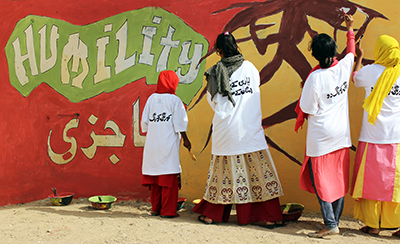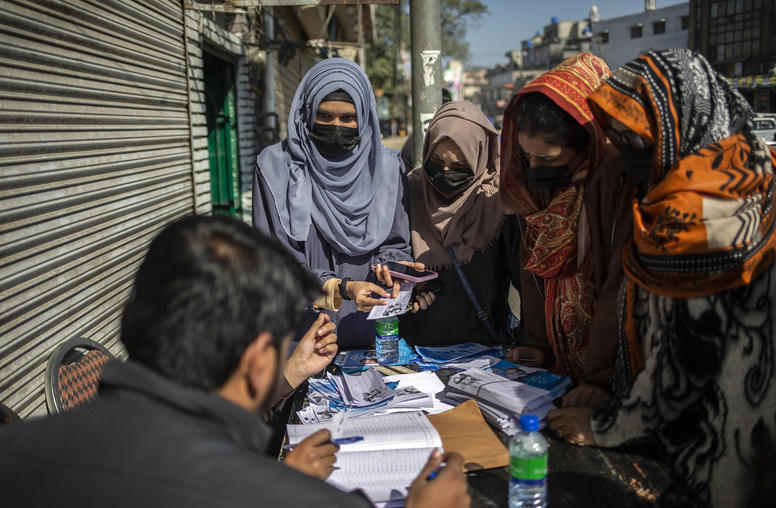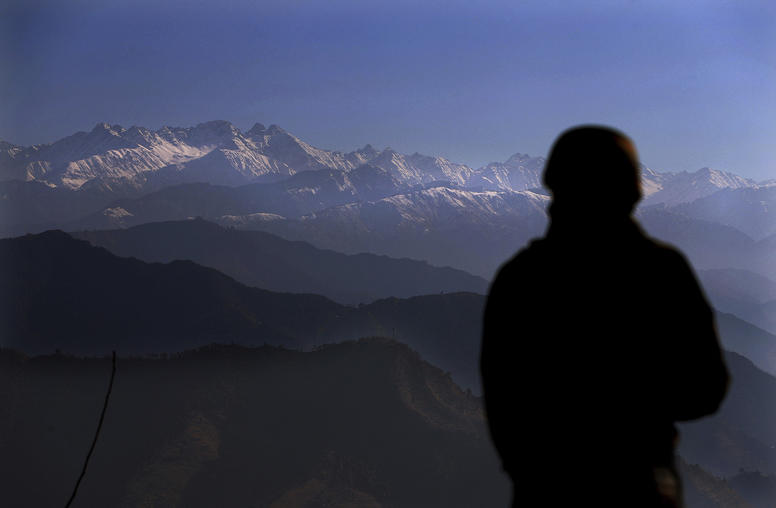The subtropical seaport of Karachi is an exploding population bomb, the world’s fastest-growing mega-city. More than 1,000 migrants pile out of buses and trains each day, ratcheting up the population of 22 million. “They leave bombed-out villages in the tribal north or parched hamlets in South Punjab to come settle at the edge of sewers in unplanned slums,” seeking survival as laborers, Karachi novelist Muhammad Hanif wrote this summer.
The migrants keep coming even though “Karachi is known for killing its residents,” Hanif wrote. Crime and battles among the city’s criminal gangs, rival ethnic militias and Pakistani Taliban pushed violent deaths to about 3,000 in each of the past three years.
“Once people feel some hope that a change can be made, you can see how much they are ready to build something better.” –Zareen Qureshi of Charter for Compassion Pakistan
But Karachi also is a hub of Pakistani culture and civil society, including a chapter of Charter for Compassion, the global movement co-led by South African Archbishop Desmond Tutu. The local group is campaigning through Karachi’s schools to build a tolerant, compassionate city. It’s a project supported by the U.S. Institute of Peace.
For both education and social peace, Pakistan’s crisis-stricken government schools may these days be as much a problem as a solution. Fully a third of Pakistani families opt to send their children to the country’s thousands of private schools. Public school curricula, still echoing the “Islamization” policies of a 1980s military regime, help create the culture that has fed extremism and terrorism over four decades, scholars say. Government textbooks teach narrow attitudes, notably toward religious minorities, India and the United States, said a 2015 USIP report by Pakistani economist Madiha Afzal.
 Photo Courtesy: Compassionate School Network |
“I’ll be blunt; the Pakistani [state] system has become more intolerant toward other religions over the years,” said Kermin Parakh, a member of the minority Parsi community and principal of one of Karachi’s most prominent private schools. “Yet a big part of the society still thinks in a broad-minded way, and we must build upon that,” said Parakh, whose BVS Parsi High School is part of the Karachi peace campaign.
“Achieving a stable and prosperous Pakistan will depend on strengthening moderate and tolerant social forces,” said Barmak Pazhwak, a USIP specialist on Afghanistan and Pakistan. “Thousands of Pakistanis in civil society are working to build that tolerance. The Karachi campaign for compassionate schools is part of this.”
Changing the Culture of Schools
In Karachi, many government schools are dilapidated and lack computers or books. Most offer little more than rote memorization of texts that, even after a 2006 reform, include “distortion of history, creation of irrational hate and blinding prejudice against non-Muslim groups,” wrote A.H. Nayyar, a prominent university professor and analyst of Pakistan’s educational system.
Charter for Compassion Pakistan (CfC) gathered 76 Karachi schools to build a supplementary curriculum to teach empathy, courage, gratitude and other elements of a more tolerant culture, said the program’s manager, Zareen Qureshi. It reaches children through classroom lessons, art, sports—and an annual contest to design community service projects for the Islamic holy month of Ramadan. A ninth-grade Ramadan contestant organized schools in wealthier neighborhoods to build libraries at some of the many Karachi schools whose children have no access to books.
At each school, CfC begins with months of intensive training for teachers, including help to write new lesson plans. “The first need is for the teachers to broaden their own minds,” said Parakh, the school principal. Afterward, CfC staff members return every month or two for workshops, classes and events to expand the new lessons and engage students, Qureshi said in a telephone interview.
Changing the culture of a school is long, slow work. “We commit to remaining engaged at each school for 10 years,” Qureshi said. “Only with that long-term commitment can the school develop enough material to institutionalize the program … [and] be changed in a lasting way through this long-term conditioning.”
Teaching Women’s Rights—to Boys
At her boys-only school, Parakh herself teaches resistance to bullying and peer pressure—and the rights of women and girls. “People tell me, ‘these women’s rights ideas should be taught in the girls’ schools, not to boys!’” Parakh said by phone. “But Pakistan is a patriarchal society; boys should be the first to learn respect for women.”
Parakh shows students the Oscar-winning documentary “Saving Face,” which depicts Pakistani women disfigured in acid attacks by men. “After the film, we discuss our society’s attacks on women,” Parakh said. “After one class, a few of the boys stopped me and said, ‘Madam, you should be teaching this with the parents, also.’ And I realized that they were seeing violence against the women in their own households.”
“Our priority is to teach our students to be humane first, then to be gentlemen,” said Parakh. “Only after that, our priority becomes their understanding of maths, sciences, history and the rest.”
CfC’s campaign, called the Compassionate School Network, says it reached 32,000 students in its first two years. “Our aim is to grow the network to 5,000 schools by the year 2018, educating approximately 2 million children of Pakistan to become compassionate leaders in the coming decades,” says the campaign’s website.
The Battle for Lyari Town
The campaign targets some of Karachi’s most violence-blighted neighborhoods, including Lyari Town, where 1.8 million people live in an area just smaller than Washington’s National Mall. (If the District of Columbia were as densely populated as Lyari, it would hold 25 million people.)
Karachi’s newspaper, Dawn, has called Lyari “Gangland.” It “resembles a war zone,” the weekly Friday Times wrote last year.
Lyari’s gang warfare, and general strikes, frequently and unpredictably shut down all public life, including the schools. “Security can be a big problem,” said Qureshi. “When a strike is called, we have no choice but to just stop what we are doing and go back to our offices.”
“Children in Lyari are quite isolated, and may not have any experience” even of the wider city of which they are a part, Qureshi said. “We felt that we had to go there” with the compassionate school campaign, she said.
Schools in Lyari are dilapidated and dangerous, say Parakh and others. This year, Parakh’s school—an elite, 156-year-old institution—began partnering with a school in Lyari, less than two miles away. “To be honest, that school needs to be cleaned,” Parakh said. “We found that it had no proper library, so our students are collecting books and we are preparing a library space and a [catalogue] system over there.”
“Unfortunately, when our children go to Lyari, I must send the guards, with guns, along with them,” Parakh said. “I don’t like to do it, but it’s necessary. It’s just how the city ticks.”
Lyari is one of many neighborhoods where the schools campaign uses public art by children to counter the esthetic and oppose the violence of Karachi’s slums. CfC gathered students to design and paint bright murals on the high, brick walls around their schools that proclaim the attributes of a compassionate society.
Playing Cricket, Overcoming Corruption
And CfC uses Pakistan’s national sports obsession, cricket, as the draw for thousands of schoolboys. Coaches teach compassion and tolerance along with the batting and fielding instruction.
With funding from a local charity, CfC brought workers and a tractor to clean and grade cricket pitches in what had been trash-strewn lots in Lyari and other slums. Local officials repeatedly obstructed the work. In Lyari, they halted the cleanup, saying that “they were concerned about the concealed pipelines under the soil bed,” a Karachi community activist said. “But we later found out that they are only interested in some cut [a bribe] from our side.”
When the cricket program held a tournament last year, it paid extra fees to have a bus company drop each young player from Lyari directly at his home after the matches because a wave of killings had made the streets unsafe. One night, CfC employees arrived at their rented field to find that members of a local political party had occupied it for their own cricket match. Forced out by armed guards accompanying the political workers, CfC had to re-schedule the tournament, paying extra costs.
Despite the obstacles, “we can see the changes come—in the students and the schools,” Qureshi said. “After some months, you see that young people are showing a real respect for you and for each other. And once people feel some hope that a change can be made, you can see how much they are ready to build something better. Then that becomes the inspiration for continuing the work.”
USIP has funded other work with Pakistanis to build a more peaceful, tolerant society, notably through their schools. The Institute supported a Canadian organization, Peaceful Schools International, in producing a guidebook to help schools in Pakistan or other developing countries create their own peace curricula. USIP also has trained a network of Pakistani mediators who work professionally to help resolve community level conflicts, such as fights over land.



